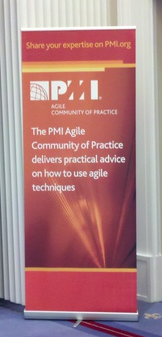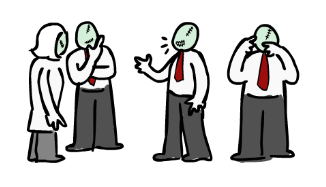 Nobody could have been more surprised about this October than me. It was, by far, the best month this year. It all started when my son kept asking me why. Over and over again, why, why, why. It lead me to write the why ask why blog post. It made me ask myself if I was still on my "Critical Path".
I think it's really easy for us to go day to day and forget why we do the things we do. We sometimes forget our goals.
Nobody could have been more surprised about this October than me. It was, by far, the best month this year. It all started when my son kept asking me why. Over and over again, why, why, why. It lead me to write the why ask why blog post. It made me ask myself if I was still on my "Critical Path".
I think it's really easy for us to go day to day and forget why we do the things we do. We sometimes forget our goals.
For the first time in a while, I thought about what was important to me and my professional goals. I realized I wanted to get more involved in both the Agile community and the PMI community. I realized I wanted to do more to educate, advise, and support. Most of all, I wanted to deliver value. You may hear me rant from time to time about the ecosystem surrounding the PMP certification. As PMI rapidly approached 400,000 PMPs, I remember back to the days when I was passionately living Agile and Scrum every day, not just overseeing a program using a heavy waterfall approach. But we all need to pay the bills. I've done what I can to leverage Agile methods where I can when I can.
It was time for a reality check. I signed up to attend the PMI North American Congress in Washington DC. A few days before it started, I met up with 4 Agile pundits, all in Washington DC, attending the PMI Leadership Institute Meeting (LIM) and representing the PMI Agile Community of Practice (CoP). After having a few drinks and exchanging ideas, it was the most inspired I had felt in over two years.
 The next week, I attended the Congress and saw two very conflicted worlds. I saw a very strong push by PMI to support Agile. Everywhere I turned, there were banners or messages supporting the PMI Agile Community of Practice (CoP). I then spent 3 days attending Agile centric sessions, all of which were introduced by Frank Schettini, Vice President, Information Technology, at PMI. The message? Agile is here to stay. PMI supports Agile. PMI uses Agile. How was any of this conflicted? The average Congress attendee appeared curious but also very ignorant to what Agile was about. I don’t find it surprising, considering there is a complete omission of the word “Agile” in PMI’s Project Management Body of Knowledge (PMBOK®) version 4.0. But, the PMBOK version 5 is in the works. A new PMP credential exam is being release in August 2011. There is hope for them yet. I met many Agile thought leaders over the course of 3 days. At the end of those 3 days, I knew I was back on the Critical Path.
The next week, I attended the Congress and saw two very conflicted worlds. I saw a very strong push by PMI to support Agile. Everywhere I turned, there were banners or messages supporting the PMI Agile Community of Practice (CoP). I then spent 3 days attending Agile centric sessions, all of which were introduced by Frank Schettini, Vice President, Information Technology, at PMI. The message? Agile is here to stay. PMI supports Agile. PMI uses Agile. How was any of this conflicted? The average Congress attendee appeared curious but also very ignorant to what Agile was about. I don’t find it surprising, considering there is a complete omission of the word “Agile” in PMI’s Project Management Body of Knowledge (PMBOK®) version 4.0. But, the PMBOK version 5 is in the works. A new PMP credential exam is being release in August 2011. There is hope for them yet. I met many Agile thought leaders over the course of 3 days. At the end of those 3 days, I knew I was back on the Critical Path.
Later in the month, on October 22nd, I attended Agile Tour DC. I was able to immerse myself in Agile for an entire day. This time, it wasn't just the speakers who knew and supported Agile. Every person I spoke to was curious, excited, and optimistic about the future.
I then published an announcement that The Critical Path had been nominated for the Computer Weekly IT Blog Awards 2010 in the area of Project Management. You can vote for me if you like.
On October 24, I found a quote by Steve Jobs that spoke to me and left me feeling inspired. About the same time, Mike Cottmeyer of Leading Agile recommended I read Dan Pink’s book, Drive: The Surprising Truth About What Motivates Us . The book had a major impact on the writing for the rest of the month.
. The book had a major impact on the writing for the rest of the month.
 Along the way, I wrote a few posts in my Zombie Project Management series.
Along the way, I wrote a few posts in my Zombie Project Management series.
On the 27th of October, Agile Scout published my contribution to their series "the State of Agile" and I focused my editorial on Mastery-based Learning and the Paradox of the Certification.
The month was concluded by my reporting that PMI had reached 400,000 PMPs. Again, I wanted to touch on mastery-based learning and the paradox of the certification.
And so concludes October 2010. One of my core professional goals is to promote Agile methods and principles. Another is to educate and inform the collective project management community on sound methods and approaches. All of this under the umbrella of mastery-based learning.
I will continue to be optimistic. The best is yet to come.
Keep your eyes out for the article I'm writing for PM Network magazine.
Stay tuned for announcements I will be making in November.
Like the image? Find it at Pictofigo
Disclaimer: The link to the book is an affiliate link. If you buy a copy, I could make $1
 As many have seen, since August, I've been using freehand drawings with many of my blog posts. They were all created by the skilled hands over at Pictofigo.
Pictofigo provides high-quality freehand drawings for agile practitioners, professionals, project managers, presenters, web designers, etc. in an easy and efficient way. Pictofigo helps communicate your message through a visual experience, rather than using huge amounts of text. Anyone can use them and it is 100% free.
As many have seen, since August, I've been using freehand drawings with many of my blog posts. They were all created by the skilled hands over at Pictofigo.
Pictofigo provides high-quality freehand drawings for agile practitioners, professionals, project managers, presenters, web designers, etc. in an easy and efficient way. Pictofigo helps communicate your message through a visual experience, rather than using huge amounts of text. Anyone can use them and it is 100% free.

 The next week, I attended the Congress and saw two very conflicted worlds. I saw a very strong push by PMI to support Agile. Everywhere I turned, there were
The next week, I attended the Congress and saw two very conflicted worlds. I saw a very strong push by PMI to support Agile. Everywhere I turned, there were 
 Along the way, I wrote a few posts in my
Along the way, I wrote a few posts in my 






